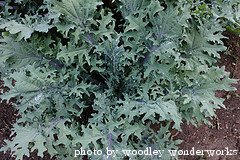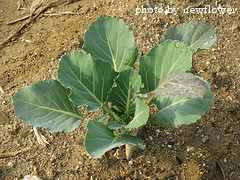Interested in Growing Kale?
You've come to the right place. The best part about growing kale is that you can grow it during the winter months, when most other stuff just won't grow. Once established, kale will tolerate below zero temperatures, though the soil needs to be at least 45 degrees F for the seeds to germinate.
Kale plants don't take up much space in the garden and they are suitable for growing in containers. Kale leaves can be harvested as they mature and the plants will keep producing as long as they remain healthy and growing conditions are favorable. To have kale on a regular basis, 3-4 plants per person are usually enough, depending on the size of the variety you choose to grow. However, it's usually a good idea to plant a few extra, just in case some don't reach maturity. It usually takes about 60 days for the first leaves to be ready for harvest, after the seedlings emerge. Kale seeds typically take about a week to germinate if the soil temps are around 60 degrees. They will take a little longer if it's a bit colder.

In most cases, kale seeds can be sowed directly in the garden. However, in cold climates, if you want to a spring kale crop, it's best to start the seeds indoors and then transplant when the soil becomes workable.
In our own garden, we only grow kale in the fall and winter months. Our spring growing season is just too short and the hot summer comes too quickly to make growing kale in the spring a worthwhile endeavor for us. We typically sow our kale seeds in late September or early October, and we start harvesting them in early December. Most years, we end up picking fresh kale leaves into mid-February.
We are often asked about our favorite kale varieties. We've tried several over the years, including Thousandhead, which produces leaves that reach 3 feet long! Our favorite varieties that we grow every year include Dazzling Blue and Dwarf Siberian.
When growing kale, the soil needs to drain well and be slightly acidic. A pH of 6.0 is ideal, although kale plants will grow well in the 5.5-6.8 pH range. Loamy soil conditions are best, but if you amend sandy or clay soils with compost to help manage moisture and nutrient levels, kale will grow just fine. In our own garden, we grow our kale in raised rows, which end up being about 6 inches tall and 6 inches across. This makes planting and harvesting just a little bit easier, because we don't have to bend over as far. In addition, the raised rows ensure good drainage and they provide a good way for us to mix composted manure into the soil just before we plant.
Quick Overview of Growing Kale
Planting: Sow seeds 1/2 inch deep in well tilled soil when temps are at least 45 degrees F, space seeds 6 inches apart and rows 2 feet apart
Fertilizing: Apply a well-balanced fertilizer before planting and again after the first leaves are harvested
Watering: Keep the soil evenly moist but not soggy
Harvesting: Begin picking outside leaves when plants reach 8 inches tall, keep harvesting as needed until the temps become too warm and then cut off the whole plant
Recipes: Kale can be eaten raw, steamed, boiled, fried, sauteed or roasted
Typically, the plants begin to bolt when temperatures top 80 degrees F and leaves become bitter and tough. Kale tastes better when grown in temps below 60 degrees F, and gets really sweet when temperatures dip below freezing. Most of the kale we harvest has been exposed to colder temperatures, and it makes a big difference when it comes to taste and flavor. We have grown kale a bit earlier in past years and the kale we harvested before the first hard freeze was typically a bit blander.
After harvest, kale usually won't last more than a week in the fridge. It's best if eaten right away, either raw, steamed, sauteed, or roasted. You can also blanch it in boiling water and then freeze it in airtight bags, where it will last for up to a year. We typically eat fresh kale for several weeks during the winter months. At some point, we get tired of it and we usually only end up freezing a couple of gallon-sized bags worth. Kale that has been frozen typically doesn't have the best texture and we end up usually using it in soups.
Click on the following links for more information about growing kale.

Click here to learn about planting kale
Click here for information about fertilizing and watering kale
Click here to learn about harvesting kale
Click here for information on different kale varieties
Click here for some of our favorite kale recipes
Click here to move from our Growing Kale page to our Home page